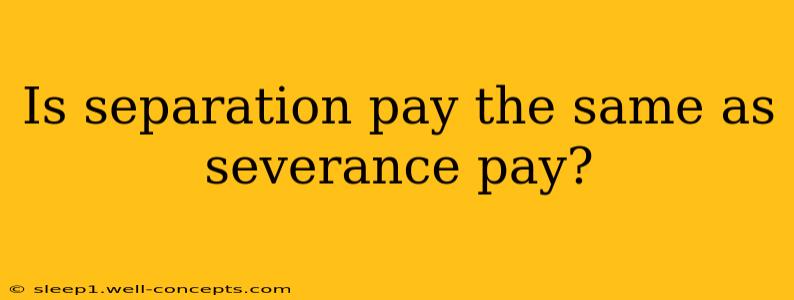While the terms "separation pay" and "severance pay" are often used interchangeably, there are subtle yet important differences between them. Understanding these distinctions can significantly impact your understanding of employee rights and employer obligations. This article delves into the specifics of each, highlighting key variations and providing clarity on when each type of pay is applicable.
What is Separation Pay?
Separation pay is a broader term encompassing any payment an employee receives upon the termination of their employment, regardless of the reason. This includes payments made due to:
- Retirement: Employees often receive a lump-sum payment or a pension upon retirement, which falls under the umbrella of separation pay.
- Resignation: While less common, some companies offer separation payments to employees who resign, particularly in cases of long-term employment or specific contractual agreements.
- Layoffs or Redundancies: In situations where a company downsizes or eliminates positions, separation pay may be offered as a form of compensation to affected employees.
- Termination for Cause: Even in cases where an employee is terminated for cause (violation of company policy, etc.), some jurisdictions or employment contracts may stipulate separation pay, although it's often less generous than in other circumstances.
What is Severance Pay?
Severance pay, on the other hand, is a more specific type of separation pay. It's typically provided to employees who are involuntarily terminated from their jobs through no fault of their own. This includes situations such as:
- Layoffs due to downsizing or restructuring: Companies frequently offer severance packages to employees affected by these actions as a form of compensation for job loss.
- Company closure: When a business shuts down, employees are usually entitled to severance pay, often dictated by employment laws or collective bargaining agreements.
- Mergers and acquisitions: During corporate restructuring through mergers or acquisitions, employees may be let go, often receiving severance packages as part of the transition.
Key Differences: A Comparative Analysis
The primary difference lies in the reason for the payment. Severance pay is almost always linked to involuntary job loss due to circumstances beyond the employee's control. Separation pay, however, is a much broader category encompassing various reasons for employment termination. Therefore, all severance pay is separation pay, but not all separation pay is severance pay.
| Feature | Separation Pay | Severance Pay |
|---|---|---|
| Reason for Payment | Various reasons for employment termination | Involuntary termination through no fault of the employee |
| Inclusivity | Encompasses severance pay and other payments | A specific type of separation pay |
| Typical Circumstances | Retirement, resignation, layoffs, termination | Layoffs, company closure, mergers & acquisitions |
| Legal Entitlement | Varies greatly depending on jurisdiction and contract | Often legally mandated or contractually obligated |
Navigating the Legalities
The legal aspects of separation and severance pay vary significantly depending on the country, state, or province, and the specifics of an individual's employment contract. Always consult with an employment lawyer or HR professional to understand your rights and entitlements. Collective bargaining agreements may also significantly influence the terms of separation or severance payments.
Conclusion
While often used synonymously, separation pay and severance pay represent distinct concepts within the realm of employee compensation upon termination. Understanding this difference is crucial for both employers and employees to ensure fair and legally compliant practices. Always review your employment contract and relevant legislation to ascertain your specific rights and obligations.

